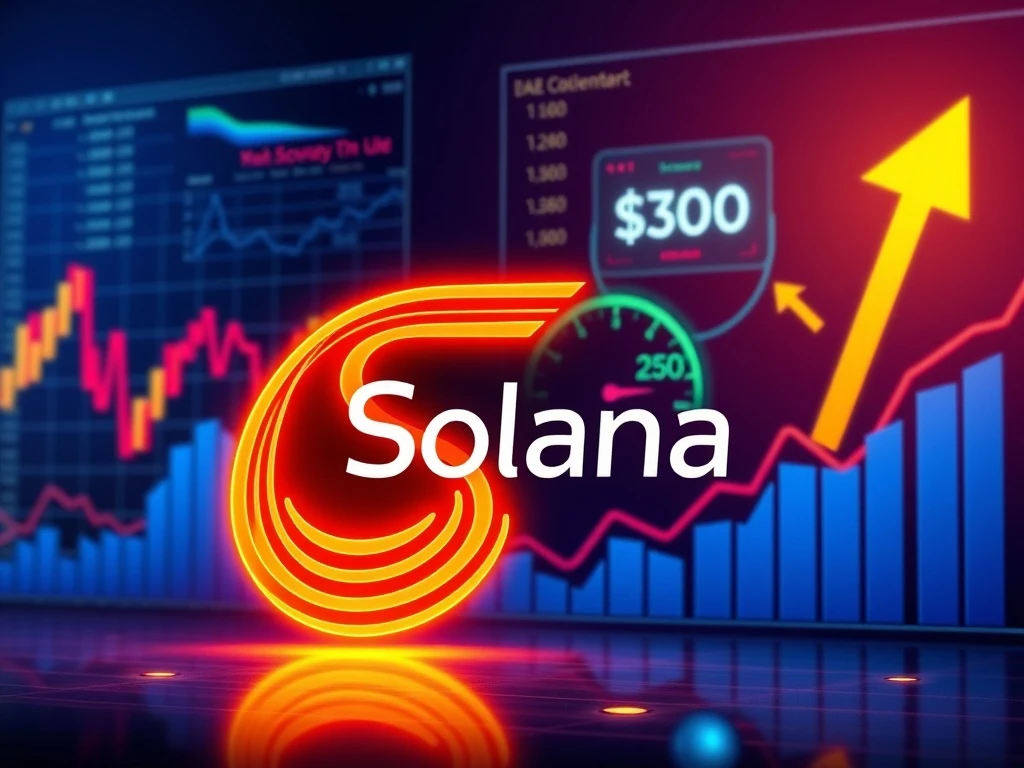Solana’s Crucial Test: Is $300 SOL Price by December Possible?

Recent market movements have brought Solana (SOL) back into the spotlight. Following a significant rebound, many investors are now asking a crucial question: Can Solana’s native token, SOL, realistically reach a $300 price target by December? This article provides a detailed crypto market analysis, exploring the metrics and challenges that will determine SOL’s trajectory.
Unpacking the Latest SOL Price Prediction and Market Dynamics
Solana’s native token, SOL, recently climbed back above the $200 mark. This recovery followed a volatile period, including a flash crash that pushed prices down to $167. However, the record $1.73 billion in long liquidations left a lasting impact on SOL’s derivatives market. Consequently, traders are now questioning the strength of the bullish momentum. They also ponder if the token can realistically hit $300 within this market cycle.
The perpetual futures funding rate, a key indicator for the derivatives market, currently hovers around 0%. Under normal market conditions, this rate typically ranges between 6% and 12%. A positive rate shows that longs (buyers) are willing to pay a premium to maintain their positions. Notably, SOL’s funding rate sat at approximately 4% before Friday’s crash, already below the neutral range. When the funding rate turns negative, it generally signals that shorts (sellers) dominate. This situation rarely lasts long due to the costs involved in maintaining those bearish bets. Nevertheless, the ongoing strain in SOL’s derivatives market likely mirrors the broader damage inflicted across the cryptocurrency sector by recent liquidations.
A Closer Look at Solana Network Activity
Despite SOL’s price recovery, Solana network activity reveals a persistent lack of bullish momentum. Even with SOL trading 31% below its $295 all-time high from January, on-chain metrics show a struggle. Network activity has not fully regained traction since the memecoin frenzy earlier in 2025. Moreover, the blockchain has started losing its lead in decentralized exchanges (DEXs) as new competitors gain significant market share.
Data from DefiLlama indicates that decentralized applications (DApps) on Solana generated $35.9 million in weekly revenue. Simultaneously, network fees totaled $6.5 million. This represents a 35% drop from the previous month. Such a slowdown directly weakens demand for SOL, which serves as the payment token for blockchain computation. Lower activity also reduces staking yields for SOL holders, adding further downside pressure to the token’s value. Sustained network growth is vital for any blockchain’s long-term health and token appreciation.
Intense Competition and its Impact on the Solana Network
The competitive landscape for blockchain networks is intensifying. Competing networks, including BNB Chain, Ethereum, and Hyperliquid, have seen their fees rise significantly. Much of this growth has come at Solana’s expense. BNB Chain, for instance, reported an impressive $59.1 million in weekly fees. This surge highlights the success of ‘four.meme,’ a memecoin launchpad platform fully integrated with Binance Wallet. This platform is positioned as a direct rival to Solana’s own Pump.fun.
Even if one considers BNB Chain’s momentum as potentially temporary, fees across the broader Ethereum ecosystem have surged. Layer-2 scaling networks such as Base, Arbitrum, and Polygon each recorded weekly fee jumps of 40% or more. Uniswap, a leading decentralized exchange, achieved its highest-ever weekly fees at $83.8 million. This was largely driven by activity on Ethereum and Base. Meanwhile, Hyperliquid also capitalized on Friday’s market volatility, posting a notable spike in trading fees. This increased competition presents a significant challenge for the Solana network to reclaim its dominant position and drive its SOL price prediction upwards.
Investor Sentiment and the Derivatives Market Signals
To gauge whether SOL traders have turned bearish, examining the balance between call (buy) and put (sell) options provides valuable insight. The SOL put-to-call volume ratio on Deribit has remained below 90% for the past week. This signals weak demand for neutral or explicitly bearish positions. Historically, when traders anticipate a significant correction, this metric often rises above 180%. This level was last reached on September 20, following an 11-day, 26.7% rally in SOL’s price. The current low ratio suggests that while bullish conviction might be muted, there isn’t widespread bearish sentiment either.
However, it is important to acknowledge that SOL’s derivatives metrics may have been distorted by the extreme volatility from Friday’s flash crash. Despite this, the ongoing weakness in on-chain activity, coupled with rival blockchains gaining momentum, remains a significant concern. The rise of platforms like Aster, Hyperliquid, and the continued dominance of Uniswap have directly impacted Solana’s potential for rapid upside. This dynamic is a key factor in any comprehensive crypto market analysis for Solana.
The Road Ahead: A Challenging $300 SOL Price Outlook
Considering the current market conditions, achieving a $300 SOL price by December appears challenging. While the lack of strong bearish conviction in the derivatives market offers some stability, stagnant network growth and shifting market share limit SOL’s upside potential. Even a single significant event, such as the potential approval of spot Solana exchange-traded funds (ETFs) in the United States, might not be enough to propel its price to $300 in the near term.
Investors must closely monitor Solana network activity, competitive developments, and broader crypto market analysis trends. The ecosystem needs to demonstrate renewed growth in DApp usage and transaction volumes to justify a substantial price increase. Without a significant resurgence in on-chain metrics and a clear competitive advantage, SOL faces an uphill battle to reach the ambitious $300 target before the year concludes.








